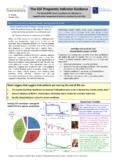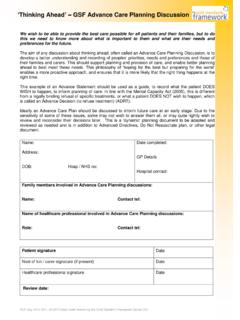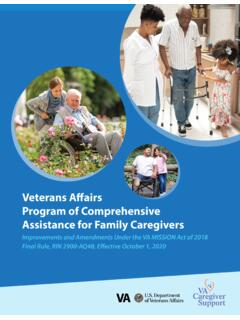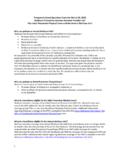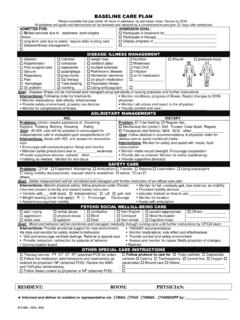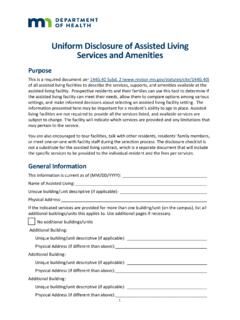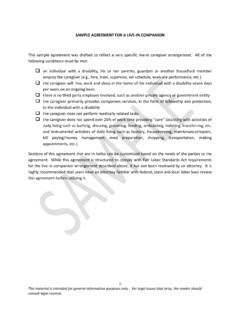Transcription of The GSF Prognostic Indicator Guidance
1 Prognostic Indicator Guidance (PIG) 4th Edition Oct 2011 The Gold Standards Framework Centre In End of Life Care CIC, et al 4th Edition October 2011 Earlier identification of people nearing the end of their life and inclusion on the register leads to earlier planning and better co-ordinated care (GSF National Primary Care Snapshot Audit 2010 ) About 1% of the population die each year. Although some deaths are unexpected, many more in fact can be predicted. This is inherently difficult, but if we were better able to predict people in the final year of life, whatever their diagnosis, and include them on a register, there is good evidence that they are more likely to receive well-co-ordinated, high quality care.
2 This updated fourth edition of the GSF Prognostic Indicator Guidance , supported by the RCGP, aims to help GPs, clinicians and other professionals in earlier identification of those adult patients nearing the end of their life who may need additional support. Once identified, they can be placed on a register such as the GP s QOF / GSF palliative care, hospital flagging system or locality register. This in turn can trigger specific support, such clarifying their particular needs, offering advance care planning discussions prevention of crises admissions and pro-active support to ensure they live well until they die.
3 Why is it important to identify people nearing the end of life? Three triggers that suggest that patients are nearing the end of life are: 1. The Surprise Question: Would you be surprised if this patient were to die in the next few months, weeks, days ? 2 General indicators of decline - deterioration, increasing need or choice for no further active care. 3. Specific clinical indicators related to certain conditions. Average GP s workload average 20 deaths/GP/year approx. proportions approximate proportions Typical Case Histories 1-2 High Low Function Onset of incurable cancer Time Often a few years, but decline usually seems <2 months Death Rapid Cancer Trajectory, Diagnosis to Death Cancer The GSF Prognostic Indicator Guidance The National GSF Centre s Guidance for clinicians to support earlier recognition of patients nearing the end of life Definition of End of Life Care General Medical Council, UK 2010 People are approaching the end of life when they are likely to die within the next 12 months.
4 This includes people whose death is imminent (expected within a few hours or days) and those with: Advanced, progressive, incurable conditions General frailty and co-existing conditions that mean they are expected to die within 12 months Existing conditions if they are at risk of dying from a sudden acute crisis in their condition Life-threatening acute conditions caused by sudden catastrophic events. 3) Mrs C A 91 year old lady with COPD, heart failure, osteoarthritis, and increasing signs of dementia, who lives in a care home. Following a fall, she grows less active, eats less, becomes easily confused and has repeated infections. She appears to be skating on thin ice.
5 Difficult to predict but likely slow decline Predicting needs rather than exact prognostication. This is more about meeting needs than giving defined timescales. The focus is on anticipating patients likely needs so that the right care can be provided at the right time. This is more important than working out the exact time remaining and leads to better proactive care in alignment with preferences. 1) Mrs A - A 69 year old woman with cancer of the lung and known liver secondaries, with increasing breathlessness, fatigue and decreasing mobility. Concern about other metastases. Likely rapid decline 2) Mr B An 84 year old man with heart failure and increasing breathlessness who finds activity increasingly difficult.
6 He had 2 recent crisis hospital admissions and is worried about further admissions and coping alone in future. Decreasing recovery and likely erratic decline exacerbation Prognostic Indicator Guidance (PIG) 4th Edition Oct 2011 The Gold Standards Framework Centre In End of Life Care CIC, et al This Guidance aims to clarify the triggers that help to identify patients who might be eligible for inclusion on the register (supportive/palliative care/ GSF/ locality registers). Once identified and included on the register, such patients may be able to receive additional proactive support, leading to better co-ordinated care that also reflects people s preferences.
7 This is in line with thinking on shared decision-making processes and the importance of integrating advance care planning discussions into delivery of care. It is based on consideration of people s needs rather than exact timescales, acknowledging that people need different things at different times. Earlier recognition of possible illness trajectories means their needs can be better anticipated and addressed. Specific tasks for each stage are part of the GSF Programmes in different settings, to enable better proactive coordinated care. GSF 3 Steps Process GSF Needs Based Coding How to use this Guidance what next?
8 Step 1 Step 2 Step 3 YES Do they have General Indicators of Decline? Do they have Specific Clinical Indicators? Ask the Surprise Question Would you be surprised if the patient were to die in next months, weeks or days? NO YES NO Don t Know NO Don t Know Reassess regularly Begin GSF Process Identify Include the patient on the GP s GSF/QOF palliative care register or locality register if agreed. Discuss at team meeting. Assess Discuss this with patient and carers, assess needs and likely support and record advance care planning discussions. Plan Plan and provide proactive care to improve coordination and communication. YES Summary of suggested three steps for earlier identification Reassess regularly Reassess regularly Prognostic Indicator Guidance (PIG) 4th Edition Oct 2011 The Gold Standards Framework Centre In End of Life Care CIC, et al Specific Clinical Indicators - flexible criteria with some overlaps, especially with Those with frailty and other co-morbidities.
9 Heart Disease At least two of the indicators below: CHF NYHA Stage 3 or 4 - shortness of breath at rest on minimal exertion Patient thought to be in the last year of life by the care team - The surprise question Repeated hospital admissions with heart failure symptoms Difficult physical or psychological symptoms despite optimal tolerated therapy. For patients with advanced disease of progressive life limiting conditions - Would you be surprised if the patient were to die in the next few months, weeks, days? The answer to this question should be an intuitive one, pulling together a range of clinical, co-morbidity, social and other factors that give a whole picture of deterioration.
10 If you would not be surprised, then what measures might be taken to improve the patient s quality of life now and in preparation for possible further decline? Are there general indicators of decline and increasing needs? Decreasing activity functional performance status declining ( Barthel score) limited self-care, in bed or chair 50% of day) and increasing dependence in most activities of daily living Co-morbidity is regarded as the biggest predictive Indicator of mortality and morbidity General physical decline and increasing need for support Advanced disease - unstable, deteriorating complex symptom burden Decreasing response to treatments, decreasing reversibility Choice of no further active treatment Progressive weight loss (>10%)


